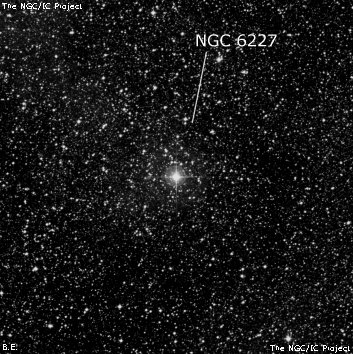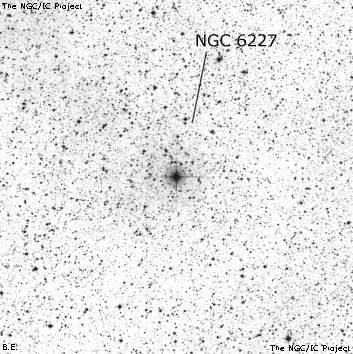NGC/IC Project Restoration Effort
(This is a very very beta version)
NGC6227


Basic Information
Location and Magnitude
Right Ascension: 16:51:30.0
Declination: -40:54:0
Constellation: SCO
Visual Magnitude:
Historic Information
Discoverer: Herschel J.
Year of discovery: 1834
Discovery aperture: 18.3
Observational
Summary description: Cl, eL, eRi (Milky Way)
Sub-type: *Cloud
Corwin's Notes
=====
NGC 6227 is described by JH as "A star 5m in a great cluster, or an immensely
rich milky way patch." The star is SAO 227313, and it is superposed on a
rich part of the Milky Way, just as JH saw it. There is a good scattering of
stars between 5th and 10th magnitude within a degree or two following JH's
star -- they stand out well on the Southern Sky Survey film. There are two
major clumps of stars here: the southern one surrounds NGC 6231, while the
northern clump is Collinder 316; Trumpler 24 is apparently a concentration in
the northeastern part of Cr 316. IC 4628, a diffuse nebula, is on to the
northeast of Tr 24. This whole region may be JH's "great cluster." The
area to the west of SAO 227313 is heavily populated with stars of the 9th and
10th magnitude, but does not stand out as much as the areas to the east.
Following JH, I've adopted the position of the bright star. The diameters
I've estimated are for a center a bit offset toward the northeast from the
star. But the star is still close enough to the center of the apparent star
cloud that it provides a handy reference point.
Brent Archinal alerted me to the information about the clusters in the area.
Here is his note:
I think there are two possibilities for this object. For one, I looked at a
DSS image here (via Skyview) and there's nothing really obvious. However,
with histogram equalization of a 30' and also a 90' field, there is a
brightening of the Milky Way around the star of about 15-18' in diameter. I
think it's most reasonable to assume that this is what JH saw.
On the other hand, could it be that JH was refering to the _really big_ 3
degree grouping of stars here, including Cr 316, Tr 24, NGC 6231, and Zeta-1
and -2 Sco? On a particularly transparent night a few years ago (from here
in Virginia), I saw this area well for the first time as it crossed the
meridian. This is a very spectacular binocular grouping of objects.
Offhand, I would think that if he was refering to such a large grouping he'd
describe it better or say something clearer about the size, so I think this
is an unlikely identification -- but perhaps still possible.
One identification I would reject is that this is one of the individual
clusters, such as NGC 6231, Tr 24, or Cr 316. The 5th magnitude star in
question is on the edge of Cr 316, but this group doesn't stand out well at
all, at least in the 90' field. Tr 24 is too far to the NE (part of Cr 316
probably), and NGC 6321 is quite obvious to the SE and doesn't fit the
description at all.
None of this information corresponds with the observation by Hirsch reported
in the Monograph, but he may have just been looking at a scattered group of
stars here, if not Cr 316 or Tr 24. The comment by Harrington is probably
copied from Hirsch (a number of Harrington's descriptions are similar to
Webb Society descriptions, but without credit), and the information from
Burnham, SkyAtlas 2000.0, and Houston does not seem useful.
Anyway, since JH doesn't describe any resolved stars here other than the 5th
magnitude one, and doesn't make any remarks that would indicate the whole 3
degree wide grouping here, the Milky Way brightening seems the best
candidate for this object. It would be nice to have some visual
confirmation of this particular area to help confirm this, though.
Observers, to your eyepieces!
Steve's Notes
=====
NGC 6227
18" (6/12/10): this description assumes NGC 6227 refers to the beautifully rich fields to the east and northeast of mag 5.2 HD 151804 (at 16 51 37.7 -41 13 50), extending over a degree. At 108x, Tr 24 is a striking, very large, bright scattered grouping that overfills the 56' field with no distinct borders. A number of the stars appeared to be grouped into long chains with smaller knots and concentrations including vdB-Ha 202 and vdB-Ha 205. On the northern side is IC 4628, a very large, irregular HII nebula that shows up best with a UHC filter. On the south edge of IC 4628 is mag 7.2 HD 152723 and 5' SW is a distinctive 8' string oriented NW-SE. About 20' S of the mag 7.2 star is a mag 6.2 star (V861 Sco) and to the NW is another 20' string extending WNW. To the south of this string is another 20' string oriented NW-SE that includes vdBH 202.
vdB-Ha 202, situated 10' NNW of mag 6.1-6.4 V861 Sco, is located in a beautifully rich region on the SW side of Tr 24. Within this string is a 15" pair of mag 10 stars and just south of a mag 9 situated 2' NW of the double is vdB-Ha 202, a faint, very rich dusting of stars that is elongated ~N-S. The cluster is dense, just 2' in length and only partially resolved. A group of faint stars spread out E-W off the south end.
vdB-Ha 205, situated 20' NE of vdB-Ha 202, consists of 20 stars mag 7.5 to 13.5 in a distinctive 4' group. The brightest star is on the NW side. The center and south side of the group is devoid of stars. A smaller clump of stars 7' S of vdB-Ha 205 is catalogued as ESO 332-011. Another string of stars 7' NE is listed as ESO 332-013.



